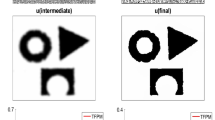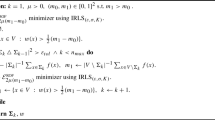Abstract
Models and algorithms in image processing are usually defined in the continuum and then applied to discrete data, that is the signal samples over a lattice. In particular, the set up in the continuum of the segmentation problem allows a fine formulation basically through either a variational approach or a moving interfaces approach. In any case, the image segmentation is obtained as the steady-state solution of a nonlinear PDE. Nevertheless the application to real data requires discretization schemes where some of the basic image geometric features have a loose meaning. In this paper, a discrete version of the level set formulation of a modified Mumford and Shah energy functional is investigated, and the optimal image segmentation is directly obtained through a nonlinear finite difference equation. The typical characteristics of a segmentation, such as its component domains area and its boundary length, are all defined in the discrete context thus obtaining a more realistic description of the available data. The existence and uniqueness of the optimal solution is proved in the class of piece wise constant functions, but with no restrictions on the nature of the segmentation boundary multiple points. The proposed algorithm compared to a standard segmentation procedure in the continuum generally provides a more accurate segmentation, with a much lower computational cost.
Similar content being viewed by others
References
Kass M., Witkin A. and Terzopoulos D. (1988). Snakes: active contour models. Int. J. Comput. Vis. 1: 321–332
Mumford D. and Shah J. (1989). Optimal approximations by piecewise smooth functions and associated variational problems. Comm. Pure Appl. Math. 42(4): 577–685
Tsai A., Yezzi A. and Willsky A.S. (2001). Curve evolution implementation of the Mumford–Shah functional for image segmentation, denoising, interpolation and magnification. IEEE Trans. Image Proces. 10(8): 1169–1184
Suri J.S., Liu K., Singh S., Laxminarayan S.N., Zeng X. and Reden L. (2002). Shape recovery algorithms using level sets in 2-D/3-D medical imagery: a state-of-the-art review. IEEE Trans. Inform. Tech. Biomed. 6(1): 8–28
Mansouri A.R. and Conrad J. (2003). Multiple motion segmentation with level sets. IEEE Trans. Image Proces. 12(2): 201–220
Kruse, F.A.: Multiresolution segmentation for improved hyperspectral mapping. In: Proc. SPIE Symposium on Defense & Security, Orlando, FL (2005)
Yang, T., Li, S.Z., Pan, Q., Li, J.: Real time and accurate segmentation of moving objects in dynamic scene. In: Proc. of the ACM 2-nd Intern. Workshop on Video Surveillance & Sensor networks, pp. 136–143, New York (2004)
Imasogie B.I. and Wendt U. (2004). Characterization of graphite particle shape in spheroidal graphite iron using a computer based image analyzer. J. Minerals Materi. Characterization Eng. 3(1): 1–12
Proc. of the Seventh International Conference on Document Analysis and Recognition—ICDAR2003, http://www.cse.salford.ac.uk/prima/ICDAR2003/
Niethammer M., Tannenbaum A. and Angenent S. (2006). Dynamic active contours for visual tracking. IEEE Trans. Autom. Control 51(4): 562–579
Kichenassamy S., Kumar A., Olver P., Tannenbaum A. and Yezzy A. (1996). Conformal curvature flows: from phase transition to active vision. Arch. Rational Mech. Anal. 134(3): 275–301
Caselles V. and Coll B. (1996). Snakes in movement. SIAM J. Numer. Anal. 33(6): 2445–2456
Caselles V., Kimmel R. and Sapiro. G. (1997). Geodesic Active Contours. Int. J. Comput. Vis. 22(1): 61–79
Osher S. and Sethian J.A. (1988). Fronts propagating with curvature dependent speed: algorithms based on Hamilton–Jacobi formulations. J. Comput. Phys. 79: 12–49
Caselles V., Cattè F., Coll B. and Dibos F. (1993). A geometric model for active contours in image processing. Numer. Math. 66: 1–31
Chan T. and Vese L. (2001). Active contours without edge. IEEE Trans. Image Proces. 10(2): 266–277
Chan T. and Vese L. (2002). A Multiphase Level Set Framework for Image Segmentation Using the Mumford and Shah Model. Int. J. Comput. Vis. 50(3): 271–293
Heiler M. and Schnorr C. (2005). Natural image statistics for natural image segmentation. Int. J. Comput Vis. 63(1): 5–19
Mansouri A.R., Mitiche A. and Vasquez C. (2006). Multiregion competition: a level set extension of region competition to multiple region image partitioning. Comput. Vis Image Understanding 101: 137–150
Cremers D., Sochen N. and Schnorr C. (2006). A multiphase dynamic labeling model for variational recognition-driven image segmentation. Int. J. Comput. Vis. 66(1): 67–81
Unal G., Yezzi A. and Krim H. (2005). Information-theoretic active polygons for unsupervised texture segmentation. Int. J. Comput. Vis. 62(3): 199–220
Aubert G. and Vese L. (1997). A variational method in image recovery. SIAM J. Numer. Anal. 34(5): 1948–1979
Shi, Y., Karl, W.C.: A fast level set method without solving PDEs. In: Proc. 2005 IEEE Int’l Conf. on Acoustics, Speech, and Signal Processing, vol. II, pp. 97–100, Philadelphia (2005)
Boykov Y. and Kolmogorov V. (2004). An experimental comparison of min-cut/max-flow algorithms for energy minimization in vision. IEEE Trans. PAMI, 26(9): 1124–1137
Funka-Lea, G., Boykov, Y., Florin, C., Jolly, M.-P., Moreau-Gobard, R., Ramaraj, R., Rinck, D.: Automatic heart isolation for CT coronary visualization using graph-cuts. In: 3-rd International Symposium on Biomedical Imaging: from macro to nano, Arlington-Virginia, pp. 614–617
Gel’fand I.M. and Shilov G.E. (1964). Generalized Functions-vol 1-Properties and Operations. Academic, New York
Jeon M., Alexander M., Pedrycz W. and Pizzi N. (2005). Unsupervised hierarchical image segmentation with level set and additive operator splitting. Pattern Recogn. Lett. 26: 1461–1469
Rudin L.I., Osher S. and Fatemi E. (1992). Nonlinear total variation based noise removal algorithms. Physica D 60: 259–268
Holliday J.D., Hu C.-Y. and Willett P. (2002). Grouping of coefficients for the calculation of inter-molecular similarity and dissimilarity using 2-D fragment bit-strings. Combin. Chem. High Throughput Screening 5: 155–166
Author information
Authors and Affiliations
Corresponding author
Rights and permissions
About this article
Cite this article
De Santis, A., Iacoviello, D. A discrete level set approach to image segmentation. SIViP 1, 303–320 (2007). https://doi.org/10.1007/s11760-007-0032-5
Received:
Revised:
Accepted:
Published:
Issue Date:
DOI: https://doi.org/10.1007/s11760-007-0032-5




